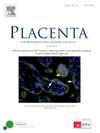妊娠合并胎儿先天性心脏缺陷的胎盘重量
IF 3
2区 医学
Q2 DEVELOPMENTAL BIOLOGY
引用次数: 0
摘要
先天性心脏缺陷(CHD)是最常见的畸形。患有冠心病的胎儿出生时小于胎龄(SGA)的风险增加,提示胎盘功能受损。我们的目的是研究孤立性冠心病孕妇胎儿心脏和胎盘之间的相互依赖性。方法回顾性队列研究,在某三级转诊中心进行。2009年至2020年间所有怀疑患有胎儿冠心病的单胎妊娠被纳入研究。根据新生儿超声心动图或尸检结果,将确诊冠心病的患者分为6个亚组。分别计算新生儿出生重(b)、胎盘重(p)、b/p比值,并比较各组间差异。结果分析确诊冠心病胎儿302例。SGA新生儿合并孤立性冠心病的总体发生率为33/161(20.4%),28.4%(38/134)的CHD胎盘重量低于第10百分位,其中以孤立性单心室病变(42.9%)和左侧心脏病变(37.1%)发生率最高。孤立病例的平均b/p比为5.32 (SD±1.51),23/134(17.2%)为>;第90个百分位。11/302(3.6%)的妊娠受到子痫前期的影响。所有新生儿均为SGA, 7/10(70%)的胎盘重量为<;第十百分位。结论小胎盘、SGA、先兆子痫发生率增高。胎儿心-胎盘血流动力学紊乱可能改变绒毛树的发育,导致胎盘和胎儿变小,提示胎盘受到二次打击,特别是在子痫前期。妊娠与胎儿冠心病应密切关注胎盘功能障碍和胎儿生长受损。本文章由计算机程序翻译,如有差异,请以英文原文为准。
Placental weight in pregnancies complicated by fetal congenital heart defects
Introduction
Congenital heart defects (CHD) are the most common malformations. Fetuses with CHD are at an increased risk of being born small for gestational age (SGA), suggesting an impaired placental function. Our aim was to investigate the interdependence between fetal heart and placenta in pregnancies affected by isolated CHD.
Methods
This was a retrospective cohort study at a tertiary referral center. All singleton pregnancies with suspected fetal CHD between 2009 and 2020 were included. Confirmed CHD were allocated to one of six subgroups according to neonatal echocardiography or autopsy. Birth weight (b), placental weight (p), b/p ratio were calculated and compared between the subgroups, respectively.
Results
302 fetuses with confirmed CHD were analyzed. The overall incidence of SGA neonates with isolated CHD was 33/161 (20.4 %), while 28.4 % (38/134) of CHD placental weights were below the 10th percentile, with the highest incidence in cases with isolated univentricular (42.9 %) and left-sided (37.1 %) cardiac lesions. Mean b/p ratio in isolated cases was 5.32 (SD ± 1.51), and 23/134 (17.2 %) were > 90th percentile. 11/302 (3.6 %) of pregnancies were affected by preeclampsia. All neonates were SGA and 7/10 (70 %) placental weights were < 10th percentile.
Conclusion
The incidence of small placentas, SGA and preeclampsia is increased in pregnancies with fetal CHD. Disturbances in fetal cardio-placental hemodynamics may alter the development of the villous tree resulting in small placentas and fetuses, suggesting a second hit on the placenta, particularly in preeclampsia. Pregnancies with fetal CHD should be followed more closely for placental dysfunction and impaired fetal growth.
求助全文
通过发布文献求助,成功后即可免费获取论文全文。
去求助
来源期刊

Placenta
医学-发育生物学
CiteScore
6.30
自引率
10.50%
发文量
391
审稿时长
78 days
期刊介绍:
Placenta publishes high-quality original articles and invited topical reviews on all aspects of human and animal placentation, and the interactions between the mother, the placenta and fetal development. Topics covered include evolution, development, genetics and epigenetics, stem cells, metabolism, transport, immunology, pathology, pharmacology, cell and molecular biology, and developmental programming. The Editors welcome studies on implantation and the endometrium, comparative placentation, the uterine and umbilical circulations, the relationship between fetal and placental development, clinical aspects of altered placental development or function, the placental membranes, the influence of paternal factors on placental development or function, and the assessment of biomarkers of placental disorders.
 求助内容:
求助内容: 应助结果提醒方式:
应助结果提醒方式:


